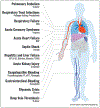Diagnosis of acute serious illness: the role of point-of-care technologies
- PMID: 34079919
- PMCID: PMC8168915
- DOI: 10.1016/j.cobme.2019.08.012
Diagnosis of acute serious illness: the role of point-of-care technologies
Abstract
Access to rapid diagnostic information is a core value of point-of-care (POC) technology. This is particularly relevant in acute, emergency, and critical care settings where diagnostic speed and precision directly guide the management of patients with potentially life-threatening conditions. Many POC diagnostics described in the literature, however, remain largely unproven and have yet to enter the market entirely. Only a few have traversed the translation and commercialization pathways to reach widespread clinical adoption. Moreover, even technologies that have successfully translated to the patient bedside still frequently lack an evidence base showing improvement of clinical outcomes. In this review, we present aspects of diagnosis of acute life-threatening diseases and describe the potential role of POC technologies, emphasizing the available evidence of clinical outcomes. Finally, we discuss what is needed to identify clinically meaningful new technologies and translate them toward the long-promised goal of better health through rapid POC diagnosis.
Keywords: Acute care; Critical care; Diagnostics; Microsystems; Outcomes; Point-of-care.
Conflict of interest statement
Conflict of interest statement Dr. Lam and Ms. Tyburski have equity in Sanguina, LLC.
Figures

Similar articles
-
The future of Cochrane Neonatal.Early Hum Dev. 2020 Nov;150:105191. doi: 10.1016/j.earlhumdev.2020.105191. Epub 2020 Sep 12. Early Hum Dev. 2020. PMID: 33036834
-
Point-of-care diagnostic technology in paediatric ambulatory care: a qualitative interview study of English clinicians and stakeholders.BMJ Open. 2022 Jun 7;12(6):e059103. doi: 10.1136/bmjopen-2021-059103. BMJ Open. 2022. PMID: 35672068 Free PMC article.
-
Point of Care Diagnostics for HIV in Resource Limited Settings: An Overview.Medicina (Kaunas). 2018 Mar 13;54(1):3. doi: 10.3390/medicina54010003. Medicina (Kaunas). 2018. PMID: 30344234 Free PMC article. Review.
-
Point-of-Care International Normalized Ratio (INR) Monitoring Devices for Patients on Long-term Oral Anticoagulation Therapy: An Evidence-Based Analysis.Ont Health Technol Assess Ser. 2009;9(12):1-114. Epub 2009 Sep 1. Ont Health Technol Assess Ser. 2009. PMID: 23074516 Free PMC article.
-
Aspects of Point-of-Care Diagnostics for Personalized Health Wellness.Int J Nanomedicine. 2021 Jan 14;16:383-402. doi: 10.2147/IJN.S267212. eCollection 2021. Int J Nanomedicine. 2021. PMID: 33488077 Free PMC article. Review.
Cited by
-
Thoracic, Peripheral, and Cerebral Volume, Circulatory and Pressure Responses To PEEP During Simulated Hemorrhage in a Pig Model: a Case Study.J Electr Bioimpedance. 2021 Dec 27;12(1):103-116. doi: 10.2478/joeb-2021-0013. eCollection 2021 Jan. J Electr Bioimpedance. 2021. PMID: 35069946 Free PMC article.
-
Deep learning on lateral flow immunoassay for the analysis of detection data.Front Comput Neurosci. 2023 Jan 26;17:1091180. doi: 10.3389/fncom.2023.1091180. eCollection 2023. Front Comput Neurosci. 2023. PMID: 36777694 Free PMC article.
-
The Role of Point-of-Care Testing to Improve Acute Care and Health Care Services.Cureus. 2024 Mar 1;16(3):e55315. doi: 10.7759/cureus.55315. eCollection 2024 Mar. Cureus. 2024. PMID: 38434607 Free PMC article. Review.
-
Detecting Stroke at the Emergency Department by a Point of Care Device: A Multicenter Feasibility Study.Med Devices (Auckl). 2024 Mar 5;17:107-112. doi: 10.2147/MDER.S445075. eCollection 2024. Med Devices (Auckl). 2024. PMID: 38476129 Free PMC article.
References
-
- Florkowski C, Don-Wauchope A, Gimenez N, Rodriguez-Capote K, Wils J, Zemlin A: Point-of-care testing (POCT) and evidence-based laboratory medicine (EBLM) - does it leverage any advantage in clinical decision making? Crit Rev Clin Lab Sci Nov. 2017, 54:471–494. - PubMed
-
- Pecoraro V, Germagnoli L, Banfi G: Point-of-care testing: where is the evidence? A systematic survey. Clin Chem Lab Med Jan. 2014, 52. - PubMed
-
- Nichols JH, et al.: Executive summary. The national academy of clinical biochemistry laboratory medicine practice guide-line: evidence-based practice for point-of-care testing. Clin Chim Acta Apr. 2007, 379:14–28. discussion 29-30. - PubMed
-
- Fanaroff AC, Rymer JA, Goldstein SA, Simel DL, Newby LK: Does this patient with chest pain have acute coronary syn-drome?: the rational clinical examination systematic review. J Am Med Assoc Nov. 2015, 314:1955–1965. - PubMed
Grants and funding
LinkOut - more resources
Full Text Sources
